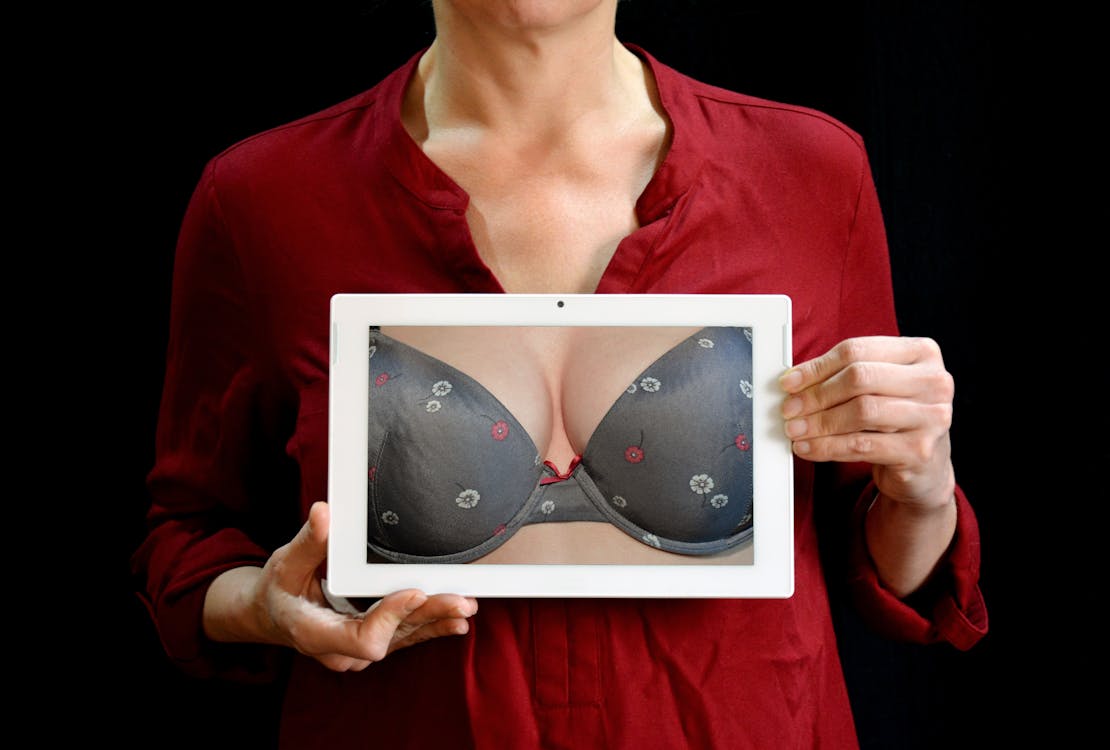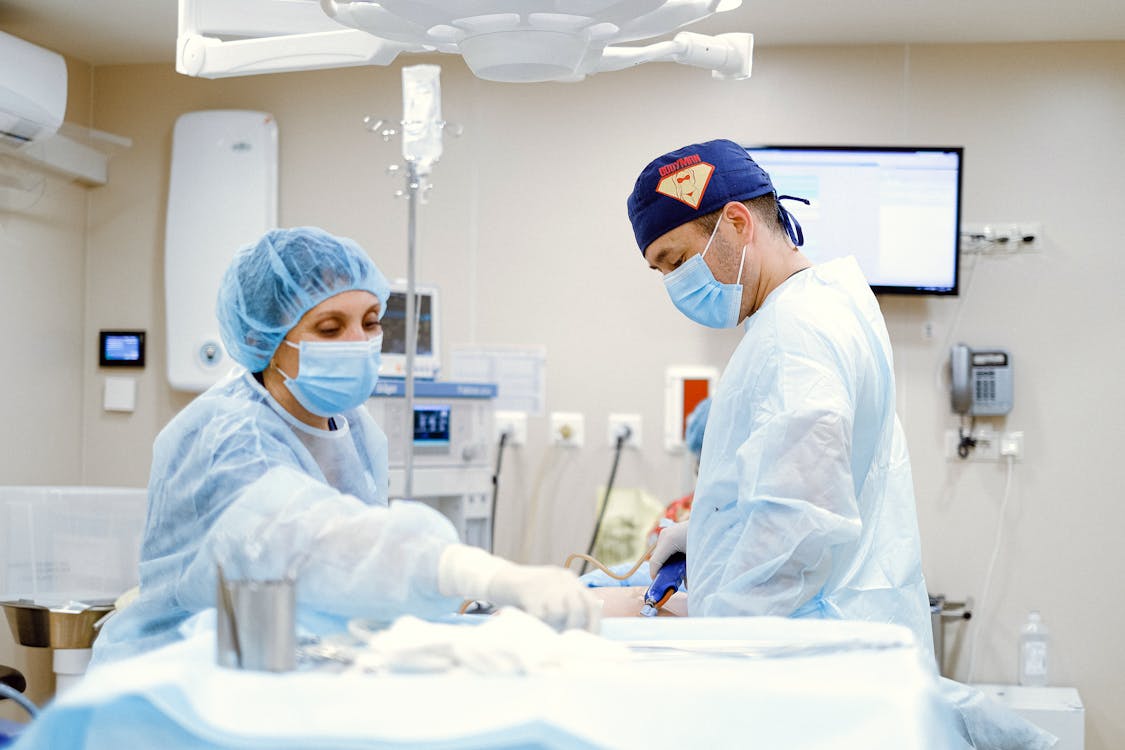
Breasts are the human mammary glands. They are found on the chest wall and are made up of connective tissue, breast tissue and fat.1 Lobes, which are made up of several lobules, produce milk. Milk ducts connect the lobes to the nipple, which allows for the release of milk. Breasts vary in size, but most have similar number of lobes (12 to 20 on average). Breasts mainly differ in size due to the amount of fatty tissue in the breast.2 Breasts also change during a female’s menstrual cycle.1 During ovulation, breasts get larger as they retain more water during this time, and blood flow to the area is increased. As one author posits, “On real women, I’ve seen breasts as varied as faces: breasts shaped like tubes, breasts shaped like tears, breasts that flop down, breasts that point up…” Basically, as long as full function and sensation exists, the breasts can take any number of forms, shapes, sizes, or shades of skin tone. The sections that follow will resent various ways in which women can change their breasts.
Table of Contents
Breast Appearance
Breast surgeries commonly referred to as “boob jobs” are surgical procedures during which the sizes of one or both of a woman’s breasts are altered. These procedures have become more popular over the last several years. Between 2014 and 2017 breast augmentations have increased by 41%.3 However, healthy breasts differ greatly in size and shape between women. Breasts also differ in their density, or the amount of dense tissue compared to the amount of fatty tissue. There is a large range of densities among breasts, but it should be noted that the denser the breast, the harder it may be for a doctor to find issues on a mammogram such as tumor or cysts.4 Women with denser breasts are also six times more likely to develop breast cancer and therefore women with denser breasts may want to get checked more often. Many women seek surgery, chemicals, lotions, mechanical devices, or special clothing to change the appearance of their breasts.
Asymmetry

Asymmetry is a common occurrence that affects more than half of all women.5 It is very normal for women of any age to have uneven breasts in regards to breast shape, position of the breasts, or volume of the breasts. Breast buds start growing at the start of puberty and it is very common for them to grow at different speeds and for breasts to be 15 to 20% different in size, but it is not normal for one not to grow at all.2 Breast asymmetry is often noticeable just by looking at the breasts, but a mammogram can also reveal asymmetries. Although asymmetry is very common there is no known cause. Three potential causes could be hormonal changes or extreme injuries, especially during adolescence, or medical/skeletal conditions such as non-cancerous tumors. It should be noted that some research has found that breast asymmetry may be an indication of increased risk for breast cancer and women who are asymmetrical may want to get mammograms more regularly.5
Breast Shape
The shapes of women’s breasts are vastly different in shape size and color. There is not one normal breast shape and the shape of a woman’s breasts may change throughout her lifetime. Changes in shape may be due to changes in size due to gaining weight or becoming pregnant. Breasts may also have stretch marks from growing in size more quickly than the skin can stretch. Also, nipple size and color may be different for various reasons.6 Nipple may look different between breasts, be bigger or smaller, be paler or darker and they may point up, down or outwards.7 Breasts are determined by genes from parents which means there is no way to change how breasts develop during a woman’s lifetime naturally. Breasts will continue to change throughout a woman’s lifetime including during puberty through menopause. It is common for women to have naturally smooth or lumpy breasts and for the consistency to change during the menstruation portion of the menstrual cycle, but they should return to normal after. If a woman finds new lumps in their breasts they should seek medical attention.7
Surgical Options
There are several types of breast surgery available to change the shape, size, weight, and look of breasts. The most popular breast surgeries include breast augmentation, which increases the size of breasts and changes the shape, breast lifts, which create perkier breasts to shape sagging breasts, and breast reductions, which reduce the size of breasts.8 These procedures may be elective or reconstructive such as post-mastectomy.

Breast Augmentation
Breast augmentation, or augmentation mammoplasty, is a surgical procedure where a breast implant is placed under breast tissue or chest muscles.9 According to 2008 estimates by the American Society of Plastic Surgeons (ASPS), approximately five percent (6 million) of the female adult population has undergone some form of breast augmentation or reconstructive surgery.12 During the procedure, a breast implant is placed behind the breast in a subglandular placement or the chest muscle in a submuscular or subpectoral placement.3 The procedure is done on patients who would like to increase their breast size or on patients who have undergone a mastectomy.

There are many reasons that women elect to have a breast augmentation. These reasons include improving the look of a woman’s breasts including sizing issues. Some women believe their breasts are too small while others would like to even out asymmetrical breasts. Others want to reduce the size of their breasts after a pregnancy or would like to improve their self-image or self-confidence. Another common circumstance is a post-mastectomy augmentation that takes place if a breast is removed due to breast cancer. In all of these situations it is important to contact a surgeon and talk about a plan for the surgery.
There are many risks that may come along with a breast augmentation surgery. These risks include scar tissue that may make the breasts misshapen, breast pain, infection, changes in nipple and breast sensation, and implant leakage or rupture.9 If a woman does decide to undergo the surgery, her surgeon will give her a specific plan based on her preferences for size, feel, and appearance. The patient may need a “baseline mammogram,” may need to adjust their medications, and will need to stop smoking before the surgery based on the doctors specifications. The patient will talk with their doctor about deciding which implant is best for them.
Breast augmentations in the United States cost anywhere from $5,000 to $10,000 depending on the specific proceudre.10 It is possible that the patient may need to stay overnight or they may be released the same day as the surgery. The surgery should take between one and two hours and it is normal for the patient to be given general anesthesia to assure the patient does not feel pain during the surgery. The doctor will make incisions under the patient’s breasts, around the patient’s nipples, above the belly button or in the patient’s underarm. Cuts made under the breast are called inframammary cuts.8 This incision type leaves a one-to-two-inch scar and allows for a larger implant to be placed. Peri-areolar incisions are incisions around the areola, which can hide the scar well. Incisions made in the armpit are known as trans-axillary incisions and allow the patient to have a breast with no scarring. The final incision type is a transumbilical cut which is made above the belly button. If this incision is chosen the implant is inserted and brought up to the breast. The type of incision will be tailored on the patient’s body and the chosen implant size.10 The implant will be placed and then the doctor will close the incisions with sutures or surgical tape.
After the procedure, the patient’s chest will be wrapped in gauze and there may be tubes for drainage. A surgical bra may need to be worn, and patients may need to recover to several days. Patients may not be able to lift heavy items for six weeks and the doctor may prescribe medicine for pain. Although the surgery may lead to swelling it should get better and the scars should fade as time goes on.10 Breast augmentations have many potential risks, but physicians have made progress in minimizing such risks, and less invasive procedures such as the periareolar, donut, or crescentic procedures are becoming more common.11 In a recent report by The European Journal of Plastic Surgery, the most commonly reported complications were poor scar healing and areolar asymmetry. There will still be a period of time until these less invasive procedures become common practice but the reduction of more severe complications in follow-up procedures is a positive step forward for elective breast augmentation. The most common complications of breast augmentation are infection, hematoma (bleeding around the area of dissection), deflation, malposition of the implant, and firmness of the breasts (capsular contracture).12 Capsular contracture is known to be the single most common adverse effect of breast implants. Capsular contracture occurs when the post-surgery scars begin to heal; in some cases these scars will actually squeeze the implant, which may increase the implant firmness. This side effect does not pose a health risk but some individuals may find it to be so off-putting that they will have a surgical correction.
Cancer detection is an important concern that has been associated with breast implants. Concern arises from the fact that implants are radio-opaque and compress the breast tissue, which may delay cancer detection both through mammography and self-exams.12 Yet these risks have proven to be minimal as the rates of cancer detection in women with implants tend to be identical or even better than those without implants. Improvements in mammography technology and increased individual self-checks have served to lessen this risk. It should be noted that while plastic surgery can often have dramatic benefits, it is also important to have realistic expectations to achieve a happy result.
Types of implants

The two most commonly known implants are saline and silicone gel.10 Both silicone and saline implants have a shell made of silicone, which is an inert polymer.3 The surface of an implant can either be smooth or textured. Smooth implants are more realistic and move more naturally while textured implants are kept more stiffly in place because it allows for more ingrowth of soft tissue. Implants vary in width, projection, and fill volumes. Each implant should be matched to each person specifically. Silicone implants are more natural in look and feel compared to breast tissue compared to saline implants. Women must be 22 years or older to get silicone breast implants due to FDA regulations. Silicone and saline implants can leak or rupture.10 If a silicone implant were to leak, the implant will deflate but there may not be obvious signs of rupture. If a saline implant were to leak the saline will be absorbed into the body without harm.10 Saline implants start with a silicone shell being inserted into the body then filled up with sterile salt water known as a saline fluid with the consistency of water. In some cases folds of the saline implants can be seen or felt. Saline implants can be postoperatively adjusted through an injection port, which allows the size to be adjusted after surgery. A woman must be 18 or over to get saline implants.3
Possible complications
Although it is very uncommon, breast augmentations may have complications, as getting breast implants is a surgical procedure including anesthesia much of the time. These risks include the following:
- Breast pain10
- Sensation change in the breast and the nipple10
- Formation of scar tissue and hardening around the implant10
- Scarring10
- Bleeding10
- Infection10
- Problems of asymmetry or other issues in shape or size10
- Leakage of the implant or rupture of the implant9
Electing to have breast surgery for any reason is a very serious decision and should be made only with awareness of all of the possible complications. These complications are not common but should be taken into consideration.
Impacts of breast augmentation
Before deciding to undergo surgery, women should consider the many factors that may come into play regarding their long-term health and happiness.
- Breast implants will not stop breasts from sagging. A breast lift is a surgical option much different from a breast augmentation that lifts the breast and may occur in conjunction with a breast augmentation. However, with time, all breasts will sag, regardless of the procedure.9
- You may need more frequent MRIs. The FDA recommends that women get MRI scans every two years starting at three years after surgery. These scans are needed to monitor silicone breast implants.9
- Breast-feeding may be affected by implants. Depending on the mother, breast-feeding may or may not be possible depending on the breast implant. Some women may be able to breast feed without issue.9
- Breast implants are costly and are not typically covered by insurance. Breast augmentations are not covered by many insurance plans unless they are deemed medically necessary, such as after a mastectomy. The original surgery, as well as screenings and any follow up surgeries may be expensive.9
- Additional surgery may be needed. This is because it is not guaranteed that implants will last. There are many factors that may affect an implant such as change in weight, aging of breast tissue, and implant rupture. Also, some women elect to have their breast implant removed. Follow-up surgery such as a breast lift or other corrective surgeries may be desired to get a natural-looking breast.9
Having breast surgery may be the best option for many women, but it is not a quick and easy procedure as there are many impactful repercussions. A woman should plan carefully how she plans to manage any obstacles that may occur after the procedure is performed.
History of breast implants
In the late 1960s, silicone gel implants were created and put on the market.3 Over the last 50 years there have been eight generations of silicone implants. The 7th and 8th generations are currently on the market and are very advanced compared to the first versions. Saline implants came into the market in the 1990s and become popular as an alternative to silicone when there was negative news about silicone implants in the 1980s and 1990s. News outlets were reporting that the silicone implants had negative effects on women’s health. These rumors have since been debunked. Silicone implants have improved and are now able to have a 96% fill compared to the previous 85% fill. The silicone molecules have also been more “cross-linked” making the silicone more cohesive.3
Breast Lifts

The breast lifts is a procedure for women who would like to make their breasts appear perkier and firmer.8 Many elect to get a breast lift to have perkier breasts after pregnancy, to improve the contour of the breast after losing weight, or because they are not satisfied with their natural breast shape. A breast lift will not change the size of breasts but it will help to reshape breasts or make breasts more symmetrical and will lift the nipple. There are four main types of breast lifts that can be done. The first is the crescent lift, which is done when there is very little sagging. An incision is made on the top half edge of the areola. This procedure may be done in conjunction with a breast augmentation. Secondly, the peri-areolar lift (known as the “donut” lift) is used when there is mild sagging. The incision is made all the way around the border of the areola. Thirdly, the vertical lift, known as the “lollipop” lift, creates one incision around the areola and another from the areola downward to the breast crease. This lift is done when the patient has excess skin and would like to reshape the breasts. Fourthly, there is the inverted T lift (known as the “anchor” lift), which is a procedure done when there is a large amount of sagging and may be done in conjunction with a breast reduction. This procedure is chosen for patients who have excess skin and sagging tissue around their breasts because it allows the doctor to reshape the breast through three incisions including one around the areola, one along the breast crease and one from the areola to the breast crease.8 A breast lift alone will not enhance the size of breasts, but breast lifts can be done in conjunction with breast augmentations to achieve the desired results. Although a breast lift can change the look of breasts for a certain period of time, natural changes to breasts will still occur as the patient ages. The breasts may also change shape or sag after the procedure due to pregnancy or losing weight.
Breast Reconstruction
Breast reconstruction may be done after a woman has one or more breasts removed. The surgery to remove a breast is called a mastectomy. Breast cancer, as well as other conditions, may require a mastectomy. The exact number of women who undergo reconstructive surgery is unknown, but the American Society of Plastic Surgeons (ASPS) estimates that 111,000 American women will undergo reconstructive surgery to correct congenital or post-mastectomy deformities.12 The surgeon seeks to recreate a breast with the patient’s desired appearance, contour, and volume. The nipple-areolar component is also recreated if the nipple has been removed. Normal breast sensation and normal breast function, such as lactation, are not repairable if the sensory nerves or milk glands and ducts have been removed or significantly injured.12 The appearance, contour, and volume of the breasts can be recreated with implants or with a woman’s own tissue. If an implant is used and one of the breasts remains, the implant is sized to match the opposite breast. When possible, the implant is placed beneath the pectoral muscle. When using a woman’s own tissue, a segment of the lower abdominal wall can be used. Other tissue options for reconstruction include the back muscle and skin or a segment of a buttock. 12
Breast Reduction
A breast reduction, or a reduction mammoplasty, is a surgery to reduce the size and weight of breasts for women who experience shoulder pain, shoulder grooves, discomfort while exercising, and other discomforts as well as for cosmetic reasons such as to improve proportions of breasts.8 Breast reductions may allow patients to involve themselves in physical activities they previously were unable to. Much of the time, patients have immediate back and shoulder pain relief. There are several techniques that may be used during a breast reduction depending on the specific breasts, the tissue being removed, and the desired outcome. Liposuction is commonly used during breast reduction surgeries, as the procedure is less invasive, shorter, gives lasting results, and has minimal scarring. The patient must want minimal change, have little to no sagging and must have mainly fatty tissue being removed. If the patient has sagging, they may want a vertical or “lollipop” breast reduction. During this procedure, one incision is made around the areola and another from the bottom of the areola downward to the breast crease. This breast reduction procedure is done when the patient has excess fat, skin and breast tissue and would like to reshape their breasts. Another option would be the inverted T or “anchor” breast reduction, which is a procedure done when there is a large amount of sagging or when the patient would like to significantly reduce their breast size. This procedure is done with three incisions: one around the areola, one along the breast crease, and another from the areola to the breast crease.8 A breast reduction is usually done using general anesthesia. The areola will be moved and fat, breast tissue, and skin will be removed. The patient will likely be able to return home the same day as the procedure and should expect soreness. Patients should be able to work within a week and should be able to exercise in three to four weeks. After a breast reduction surgery, the breasts will continue to change due to natural aging, weight gain, or pregnancy.8
Choosing a Doctor

One of the most important decisions regarding breast augmentations is choosing a surgeon to do the procedure.8 The patient should ask the surgeon how many breast augmentations the doctor has performed and the patient should also look at the surgeon’s previous work including before and after pictures. To ensure the safety of the patient, it is important to make sure the surgeon is board certified to be sure they are accredited. It is recommended that women chose a surgeon with experience of at least five years of surgical training and two years of plastic surgery experience.10
Non-Surgical, Non-Medical Options
Many women seeking changes in their breast size cannot afford drastic surgeries, expensive medications, or special mechanical devices. Even for those who can afford the previously mentioned options, the potential risks, along with personal values, may factor in to choosing non-surgical, non-medical options. Luckily, there have been a number of safe, inexpensive products released for women who wish to change the appearance of their breasts.
The WaterBra
The Water Bra is a regular brassiere with two fluid filled sacs inside the cups. The sacs are specially designed to resist breakage and will seal off if punctured to avoid embarrassing leakage. This bra is intended to be very good at simulating actual breast shape, movement and feel. Additionally, the fluid is positioned in such a way as to promote cleavage and lift. A variety of manufacturers offer the bra both online and in stores. The bras range from about $30 to $50 USD.
Gel Inserts
Gel inserts can be purchased in a number of lingerie and women’s stores and online for about $25 USD. These inserts are helpful because they can be inserted in any bra as desired to increase lift, volume, and appearance of cleavage. The inserts are a safe, inexpensive, non-permanent way to increase breast size.
Padded Bras

Padded bras, also marketed as “push-up bras”, are very popular and are a completely reversible option for a natural looking breast enhancement. These bras are very popular and in the United States they range anywhere from $10 to $70 depending on the brand of the bra. They are easily accessible in many stores and online but being fit in a store by a professional may lead to a more comfortable fit. These bras have a foam insert sown into the bottom of the breast cup to lift the breasts up and together. Gel inserts can also be used in conjunction with padded bras. The padded bra is a quick and easy way to achieve the breast look a woman desires without any surgery or exercise.
Breast Reduction Exercises
There are many online sites that give tips for reducing chest size naturally. These sites may give specific exercise plans or may show video tutorials on what exercises may help. Because, as mentioned before, breasts mainly differ based on the amount of fatty tissues, the websites should mention that the exercises will not decrease breast tissue, but instead they will reduce fatty tissue all over the body, including the breasts.2 The exercises may also work out the pectoral muscles to make the chest look more lifted. Doing exercises to reduce breast size may be a cheaper and safer alternative to a breast reduction surgery. It is suggested to always maintain a healthy lifestyle and to eat healthfully. By staying healthy some women may be able to maintain a healthy weight and not increase their breast size to an undesirably large size.
Concluding Remarks
The breast dissatisfaction many women experience may be due to the fact that they feel that their breasts do not fit a specific cultural ideal. Currently in America, the entertainment industry and popular images in magazines and movies tell us that our culture values large, symmetrically shaped breasts and a good deal of cleavage. It is unclear whether or not the media has caused significant changes in the desire for “perfect” breasts, but the fact remains that the social trends concerning breast augmentation can be seen quite negatively. For example, the average age of women requesting breast augmentation has dropped since the late 1980s. If you are experiencing dissatisfaction about your breast size, shape, color, or appearance, and are considering some of the options above, try to remember that there is no such thing as “perfect” breasts. The drastic measures women take to fit into an ideal image of beauty may be dangerous or expensive, and might not even produce the desired result. There are also many products being marketed as safe and natural breast enhancement remedies including pills and creams. These products have not been proven to significantly increase breast size and have not been deemed safe by the FDA in most cases. These products should be used with extreme caution and only with the recommendation of a doctor. It is important to research every product being used and to rely on reliable medical advice from a physician. Overall, it is of the utmost importance that women are cautious with what products they use to change their breast shape or size.
Warning: The Food and Drug Administration has linked breast implants to anaplastic large cell lymphoma (ALCL), which is a rare immune system cancer. The FDA has some reason to believe that there is a very low but increased risk for women who have breast implants to develop ALCL.9
References
- NCI Dictionary of Cancer Terms. (n.d.). Retrieved February 26, 2018.
- My Breasts Are Different Sizes – Am I Normal? (n.d.). Retrieved February 26, 2018.
- American Society of Plastic Surgeons. (n.d.). Retrieved February 26, 2018.
- Dense Breasts: Breast Cancer Risk Factors. (n.d.). Retrieved March 13, 2018, from.
- Naik, A. M. (n.d.). Uneven Breasts. Retrieved February 26, 2018.
- Are My Breasts Normal? | Facts About Women Anatomy. (n.d.). Retrieved March 14, 2018.
- Breast development: are my breasts normal? (2017, November 10). Retrieved March 13, 2018.
- Breast Augmentation Surgery Information. (n.d.). Retrieved February 27, 2018.
- Breast augmentation. (2018, January 12). Retrieved February 26, 2018.
- Breast Implants. (n.d.). Retrieved February 26, 2018.
- (2012). Combined superior crescentic total glandular augmentation mastopexy: report of 37 cases. European journal of plastic surgery, 35(1).
- Broody, Gary S. “Silicone Breast Implant Safety and Efficacy.” Medscape Reference. Http://reference.medscape.com/, 16 Feb. 2012. Web. 15 Apr. 2012.
Last Updated: 14 March 2018.
